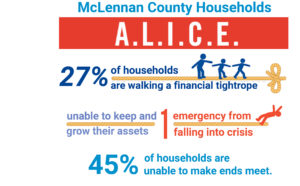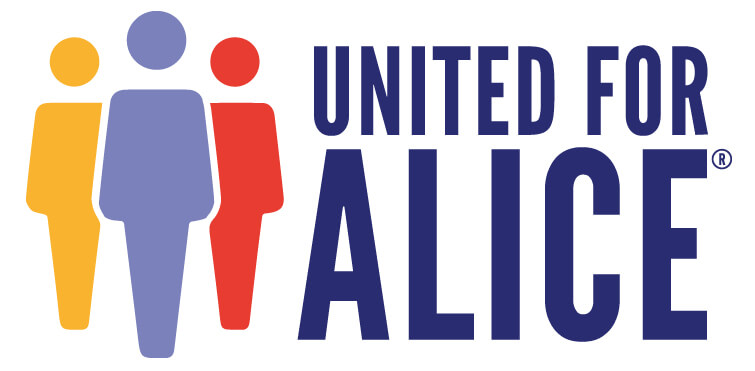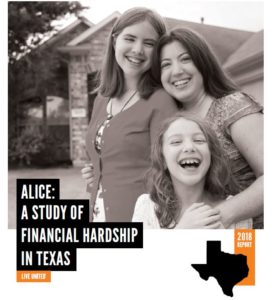United Way Impact: Who is ALICE?
By Madison Fraser
ALICE is someone you already know. They are your next-door neighbor, your cashier at the grocery store, your waiter, an office worker, and many of the other people who keep our economy running. ALICE cannot always pay the bills, has little or nothing in savings, and is forced to make tough choices such as deciding between quality child care or paying the rent. One unexpected car repair or medical bill can push these financially strapped families over the edge.
ALICE is employed at a job that does not pay enough to afford the basics of housing, child care, food, transportation, and health care. Their salaries and pay rates may be enough to barely get by if nothing ever goes wrong, but not enough to establish stability. There is little hope for financial resiliency for people at this income level.
“ALICE” stands for “Asset Limited, Income Constrained, Employed.” People in this situation are at the center of focus for United Ways, government agencies, nonprofits, and corporations. These kinds of organizations are starting to work together to evaluate current initiatives and discover innovative approaches that give ALICE a voice. They are presenting data that can spark meaningful discussion, attract new partners, and ultimately inform strategies for positive change that can improve life for ALICE and the wider community.
Dr. Stephanie Hoopes, Ph.D., is the lead researcher, director, and author of the ALICE Reports. Dr. Hoopes began this effort with a pilot study of a more accurate way to measure financial hardship in Morris County, New Jersey in 2009. Since then, she has overseen its expansion into a broad-based, state-by-state research initiative. Her research on the ALICE population has garnered both state and national media attention. Dr. Hoopes joined United Way full time in 2015. Since then, the ALICE Project has grown to 17 participating states and over 3,000 counties.
Each ALICE Report uses standardized measurements to quantify the cost of a basic household budget in each county in each state, and to show how many households are struggling to afford it. The ALICE research team developed four ALICE measures to identify and assess financial hardship at a local level and to enhance existing local, state, and national poverty measures. The Household Survival Budget is a minimal estimate of the total cost to maintain a household. The ALICE Threshold represents the minimum income level necessary for survival for a household. The ALICE Income Assessment is a tool that measures how much income households need to reach the ALICE Threshold; how much they actually earn; how much public and nonprofit assistance is provided to help these households meet their basic needs; and the Unfilled Gap — how far these households remain from reaching the ALICE Threshold despite both income and assistance. The ALICE Housing Stock assessment calculates the number of housing units in a county that ALICE and poverty-level households can afford compared with the demand for affordable units. More information on ALICE Research and Methodology Overview.
To provide a better understanding of ALICE in Texas, United Ways throughout Texas are sharing an ALICE report. This 135-page report is based on years of research and data from Texas households. It shows that 28 percent of Texas families are ALICE. Combined with households in poverty, this means that 42 percent of Texas families do not earn enough money to meet the Household Survival Budget that uses conservative estimates on monthly expenses. Low-wage jobs are prevalent in Texas, with 62 percent of all jobs paying less than $20 per hour. As contract work and on-demand jobs have increased, job instability has increased, making it difficult for ALICE workers to meet regular monthly expenses or to establish savings.
Adriana Cuellar Rojas, President and CEO of United Ways of Texas, says that a goal in releasing this report is to inform Texas communities, policy makers, funders, coalitions, and organizations in order to more effectively help the ALICEs of our state. The data may help guide public policy or, as in the instance of another state’s ALICE report, inform federal agencies, like FEMA, in their response to ALICE families impacted by disasters. Read the full Texas ALICE Report.
ALICE in McLennan County
Twenty-seven percent of McLennan County households are walking a financial tightrope, unable to keep and grow assets, and are only one emergency away from falling into crisis. Even higher than the already startling 42 percent combined percentage at the state level, 17 percent of families are living below the federal poverty line and 45 percent of households are unable to make ends meet here in McLennan County. As the number of households below the ALICE Threshold changes over time, families will continue to move in and out of poverty and ALICE status as their circumstances improve or worsen. Conditions have improved for some families, but with rising costs, many still find themselves struggling.

In 2016, the annual salary for survival budget for a McLennan County family with two adults and two children was $51,660 – more than double the federally recognized family poverty level of $24,300. The Household Survival Budget reflects the bare minimum that a household needs to live and work today. It does not include savings for emergencies or future goals like college or retirement. In comparison, the stability budget for the same family would need to be $92,748 annually to establish those goals as realistic opportunities. View data about ALICE in McLennan County.
The way Americans live is changing, especially here in McLennan County. Our population is rapidly increasing with a 7 percent growth rate per year since the last census in 2010, as well as housing costs and the decrease of affordable housing as a result of reconstruction and additions to the city landscape. There are more family and living combinations that are different than ever before, including more adults living alone, with roommates, or with their parents. Families with children are changing. There are more non-married cohabiting parents and blended families with remarried parents. The number of senior households is also increasing. Yet all types of households continue to struggle. ALICE and poverty-level households exist across all of these living arrangements in our community.
The ALICE report is about far more than poverty. It reveals that almost half of us are struggling to make ends meet. It reveals profound changes in the structure of Texas’ communities and jobs, as well as in our local community. It also reveals that hardworking families and individuals often are unseen, unknown, and are at-risk almost every day. The lack of accurate information about the number of people who are “poor” distorts the identification of problems related to poverty, misguides policy solutions, and raises questions of equality, transparency, and fairness.
United Way of Waco-McLennan County, in partnership with United Ways of Texas, is taking an active role in addressing these issues. We encourage McLennan County residents and community members to read the ALICE Report and to collectively and collaboratively consider ways to improve the lives of ALICE families in our community. Together, we can all fight for ALICE.

Madison Fraser is a recent graduate of Baylor University where she earned her BA in journalism in 2018. Currently she serves as the Campaign and Communications Coordinator at United Way of Waco-McLennan County where she discovered her passion of community building and advocacy through the work of nonprofits.
The Act Locally Waco blog publishes posts with a connection to these aspirations for Waco. If you are interested in writing for the Act Locally Waco Blog, please email [email protected] for more information.
Resources
United Ways of Texas, United Way of Greater Houston, United Way of Northern New
Jersey


